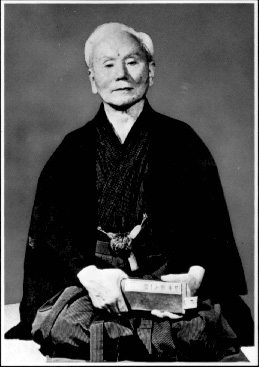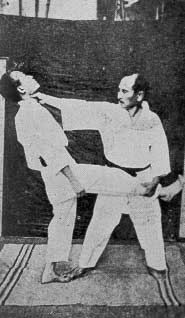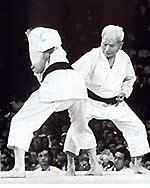|
|

GRAND MASTER GICHIN FUNAKOSHI
FOUNDER OF SHOTOKAN KARATE
Origins
Although the popular notion is that Karate was initially developed in Okinawa, it's
roots are thought to stretch back over 1400 years to Daruma, the founder of Zen
Buddhism. Daruma travelled from India to China to teach Buddhism and taught his
followers techniques to develop and strengthen mind and body, many of which are
basic to modern Karate. His methods were taught in the Shaolin Temple in China,
where they eventually devloped into the fighting technique known as Shaolin boxing.
Shaolin boxing made its way to Okinawa around the 16th century and was combined
with some indigenous Okinawan techniques to form several different fighting styles.
During many periods of Okinawan history, the general population were forbidden to
own or carry weapons and this resulted in rapid advancement of fighting techniques
and the underground development of fighting styles using bare hands or common farming
implements.
These forms of fighting were known as Okinawa-te or Tode (Chinese Hand) and resulted
in the formation of three distinct styles, Shuri-te, Naha-te and Tomari-te (named
after the cities where the styles were practiced).
The Shorin-ryu style of karate is though to have originated from Shuri and Tomari
and Shorei-ryu from the city of Naha.
The Shorin-ryu style consisted of fast, linear movements with natural breathing,
whilst Shorei-ryu taught strong, rooted techniques with synchronous breathing.
Gichin Funakoshi was born in 1868 in Okinawa and began to study karate at the age
of 11. He studied under many great Okinawan masters of the time and rapidly became
adept at both the Shorin and Shorei styles. In fact many of today's modern Shotokan
katas have their roots in the original Okinawa-te or Tode katas.
Tode could also be pronounced as kara and so Tode-te became Kara-te or 'Chinese
hand'. Funakoshi adopted the alternate meaning for the chinese character for 'kara'
which is empty and so kara-te came to mean 'empty hand'.
Karate in Japan

Karate was first demonstrated in Japan in 1917 by Gichin Funakoshi at the Butoku-den
in Kyoto. He was invited back in 1922 by Dr, Jano Kano, the founder of Judo, and
remained in Japan to teach Karate at the Kodokan Dojo with the backing of the Judo
master.
Karate gained massive popularity with university students and Funakoshi continued
to teach at various colleges around Japan.
It is at these colleges and universities that many of the modern masters such as
Nakayama, Obata, Noguchi and Watanabe were introduced to the art.
By the mid 1930's Gichin Funakoshi started to have less to do with the running of
his clubs and handed control to his son Yoshitaka. Yoshitaka continued to modernise
the style until in 1936, the Funakoshi's opened a new central dojo - the Shoto-kan
(hall of shoto). Shoto was the pen name Gichin Funakoshi used to sign the poems
he had written in his youth.

World War II had a serious effect on the growth of Karate in Japan, as many of the
former practitioners went off to serve in Japan's armed forces. The additional blows
of the death of Yoshitaka, the destruction of the Shoto-kan and the banning of Martial
Arts by the conquering Allied forces, left Shotokan Karate in complete disarray.
Gichin Funakoshi managed to get the ban on Karate lifted and in 1948 the Nihon Karate
Kyokai (Japan Karate Association) was formed, with Master Funakoshi named as chief
instructor. Due to Funakoshi's advancing age (81), Masatoshi Nakayama took on most
the teaching and Hidetaka Nishiyama headed up the instruction committee.
Master Funakoshi died in April of 1957. Engraved o his tombstone are the words "Karate
ni sente nashi" or "There is no first attack in Karate".
After his death, Funakoshi's students adopted "Shotokan" as the name of the style
of karate they practiced and today Shotokan is one of the most popular martial styles
in the world.
Shotokan Karate - History and Tradition
The beginnings of modern-day karate date back to 560 AD when Daruma Boddhidharma,
the founder of Zen Buddhism, left western India and traveled thousands of miles
alone to teach in China. He found many students eager to listen to his ideas but
physically unable to keep up with him. So he designed a method of training to develop
his followers' physical strength, which he considered a crucial aid in attaining
spiritual strength. His reasoning became the basis of karate-do, or "the way of
the empty hand." Although he felt that the way of Buddha was preached for the soul,
he taught that "the body mind and soul are inseparable."
The Creation of a Karate Style

Shotokan Karate is one of the oldest and most popular styles of Karate. It was developed
at the beginning of the last century by Master Gichin Funakoshi (1868-1957) from
the southern Japanese island of Okinawa.
Two relatively different styles - in spirit as well as in mechanics - used to exist
in Okinawa in late 19th Century: Shorei-ryu and Shorin-ryu The former was designed
for well built people, placed emphasis on developing physical strength and was impressive
in its shear power. The latter was light and quick, with fast strikes and counterattacks,
designed for people who were small in size and very agile.
After years of intense study of both styles, Master Funakoshi arrived at a new understanding
of martial arts, and a novel style was created, that combined the ideals of Shorei
and Shorin.
As in all Karate styles it is Katas, formal sequences of basic techniques, that
form the backbone of the tradition. The traditional Japanese martial arts, Judo
and Kendo, two of the seven traditional paths to enlightenment in Japanese classical
culture, were heavily centered around combat (Kumite). Master Funakoshi instead,
in the centuries old Okinawa tradition, sought a path to spiritual depth through
individual technique. Thus, Shotokan initially developed as a formal style with
little Kumite application, instead focusing on breathing, releasing energy and outstanding
mind and body control.
Penetrating Mainland Japan
In 1922, the first Karate Demonstration was held in Tokyo by Master Gichin Funakoshi
and had made a powerful impression on the Japanese public. After that, Karate became
very popular and spread very fast in Japan. From the beginning, Master Funakoshi
insisted on teaching Karate to college students. The first Karate-do Club was in
Keio University. Today, Karate-do is spread into many countries around the world.
In May 1948, the Japan Karate Association (JKA) was founded by the students of Master
Gichin Funakoshi, and the standards of training (Kihon, Kata, Kumite) and competition
were established.
House of Pine Waves

the sound that pine trees make when the wind blows through their needles." Some
people also translate this to mean the waves that pine trees seem to make visually
when bending in the wind. Master Funakoshi signed his works of calligraphy with
the pen name Shoto. That is where the first part of the name of this type of karate
came from. The word kan means building. The name Shotokan comes from the world's
first karate dojo, which was constructed in 1939 by Funakoshi's students. They placed
a plaque over the door that said "Shotokan", or " The Hall of Pine Waves", in honor
of Funakoshi. This first dojo was completely destroyed in an American bombing raid
on Japan in 1945.
|